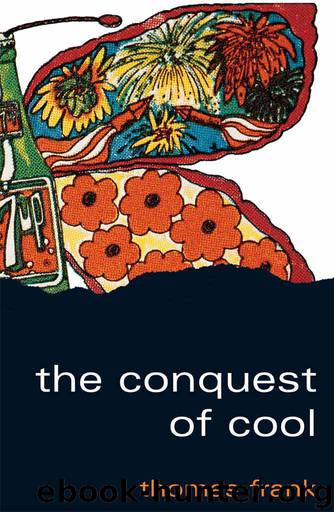The Conquest of Cool: Business Culture, Counterculture, and the Rise of Hip Consumerism by Frank Thomas

Author:Frank, Thomas [Frank, Thomas]
Language: eng
Format: azw3
Publisher: University of Chicago Press
Published: 1998-10-20T16:00:00+00:00
chapter eight
CARNIVAL AND COLA: HIP VERSUS SQUARE IN THE COLA WARS
Pepsi and other such companies have been more interested in the term segment as a verb than as a noun. They have segmented markets, rather than merely responded to a market segment that already existed. There was no such thing as the Pepsi Generation until Pepsi created it.
—RICHARD S. TEDLOW, NEW AND IMPROVED
One of the most dramatic confrontations of the new hip consumerism with its predecessor took place in the 1960s on the battlefields of what has been called “the cola wars.” While the near-universal hegemony of Coca-Cola was a product of an earlier marketing paradigm, the rapid rise of Pepsi during the 1960s was made possible by an ad campaign that made skillful use of the subversive, anarchic power of the carnivalesque and of the imagery of youth rebellion. Ever since the invention of the Pepsi Generation in the early 1960s, Pepsi has offered not just a soda but a vision of its consumers as impudent insurrectionaries, sassy upstarts flouting the dull, repressive mores of the past. As with 7-Up, enlisting youthful vitality and insurgency was a natural strategy for Pepsi, locked in a difficult battle with longstanding market leader Coca-Cola. The Pepsi-Cola Company wanted Americans to question the “establishment” in the most real sense of all, to turn away from established tastes and preferences.
Both Coca-Cola and Pepsi were invented in the American South in the late nineteenth century, and both were originally dispensed as patent medicines in soda fountains. Both are made from similar ingredients, namely, sugar, water, and a flavoring derived from the African kola nut; and both taste remarkably alike. But owing to its earlier start and its more aggressive marketing, Coca-Cola long dominated the soft-drink world, with Pepsi-Cola, the imitation beverage, lagging far behind. Pepsi only became a real competitor in the 1930s, when, with the colorful Walter Mack as its president, the company began to offer twelve-ounce bottles for the same price as Coke’s six-ounce package (backing the effort with a catchy radio jingle). But in the meantime, Coca-Cola had become a veritable symbol of all things American under the guidance of its deeply religious founder Asa Candler and his successor, conservative Southerner Robert Woodruff.
Both giants of the soft-drink industry are and have long been very much concerned with the production of advertising. Since soda is not a basic necessity or a traditional beverage choice, and since the soda consumer chooses between many brands with almost indistinguishable flavors, advertising alone must make the product appealing.1 Image—established with massive advertising campaigns—is the name of the game in the soda industry. So much so that officials associated with both cola giants have made almost identical public statements attesting to the priority of advertising to product at their companies.2 But it was not until the 1960s that Pepsi hit upon the images that would make them the second soft-drink superpower.
Since the sixties, Pepsi’s advertising strategy has aimed to identify the drink with a certain model consumer, an ideal with which the viewer was encouraged to identify himself.
Download
This site does not store any files on its server. We only index and link to content provided by other sites. Please contact the content providers to delete copyright contents if any and email us, we'll remove relevant links or contents immediately.
| Africa | Americas |
| Arctic & Antarctica | Asia |
| Australia & Oceania | Europe |
| Middle East | Russia |
| United States | World |
| Ancient Civilizations | Military |
| Historical Study & Educational Resources |
Cat's cradle by Kurt Vonnegut(15145)
Pimp by Iceberg Slim(14312)
4 3 2 1: A Novel by Paul Auster(12261)
Underground: A Human History of the Worlds Beneath Our Feet by Will Hunt(11996)
The Radium Girls by Kate Moore(11896)
Wiseguy by Nicholas Pileggi(5639)
Perfect Rhythm by Jae(5302)
American History Stories, Volume III (Yesterday's Classics) by Pratt Mara L(5238)
The Fire Next Time by James Baldwin(5221)
Paper Towns by Green John(5061)
Pale Blue Dot by Carl Sagan(4883)
A Higher Loyalty: Truth, Lies, and Leadership by James Comey(4820)
The Mayflower and the Pilgrims' New World by Nathaniel Philbrick(4402)
The Doomsday Machine by Daniel Ellsberg(4395)
Killers of the Flower Moon: The Osage Murders and the Birth of the FBI by David Grann(4367)
The Sympathizer by Viet Thanh Nguyen(4286)
Too Much and Not the Mood by Durga Chew-Bose(4253)
The Borden Murders by Sarah Miller(4214)
Sticky Fingers by Joe Hagan(4083)
